The Damariscotta River Association (DRA) property in Newcastle, Maine, sits perched between US Route 1 and the Great Salt Bay. Over the past 50 years, this former pasture land has spawned a white pine community that is now under threat from oriental bittersweet (Celastrus orbiculatus), an exotic invasive vine that strangles, smothers, and overburdens native vegetation. With DRA permission, I’ve been working to control this invasion. “Control” is a key word here, as those familiar with bittersweet will know that it’s probably impossible to eradicate a large, established infestation.
In my 40 years of mechanically battling oriental bittersweet, I’ve learned that only one approach will provide any measurable result: persistence. As Calvin Coolidge once noted, “The slogan ‘press on’ has solved and always will solve the problems of the human race.” Press on indeed, since it takes about two hours of tedious, repetitive, back-breaking labor to clear 150 square feet of bittersweet in an intensively infested area.
Bittersweet stems and roots form a nearly impenetrable tangle that can completely dominate an area, so the first challenge of any control effort is to clear space amidst the thicket. Cutting the plant itself is a simple task. Bittersweet has a soft, woody stem that can be easily sliced through with hand-held pruners or lopping shears. Only very old stems achieve a diameter that requires a saw, and even then a small folding saw will do nicely. Some may feel the need for power in the form of a brushcutter or chain saw, but I’ve found that both tools are of limited utility in a thicket of dreadlock intensity.
My particular method is to cut each stem about 4 feet from ground level. I then attempt to pull the remaining stem out of the ground. If the rooted stem gives more resistance than my back and arms can take, I simply cut it at ground level. The gap between where the first cut is made and ground level serves two purposes. First, it provides a quick visual cue as to where the work is complete, which is important when working an extensive and complex site over an extended period of time. Second, the cut stumps will generate new shoots that will reach for a handhold to rescale the tree. The gap impedes this process.
Pulling bittersweet out by its roots essentially rototills an area. As the main root stem arises, it turns over the soil in chunks, followed by masses of fibrous roots that are matted with clumps of soil. The ground can be pleasingly friable, with a just-tilled look. This may ultimately be a problem, as seeds will fall into an area of optimal growing potential.
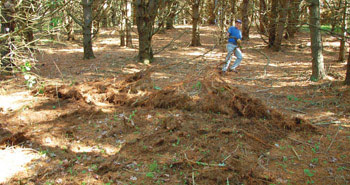
Once the stem and root are pulled from the ground, I fetch them up in pile, or on top of a dead branch, so that they are sure to dry out and die. Bittersweet’s ability to re-root may not match its athletic growth characteristics, but there is little sense leaving that to chance after the spine-spraining struggle to remove it from the earth.
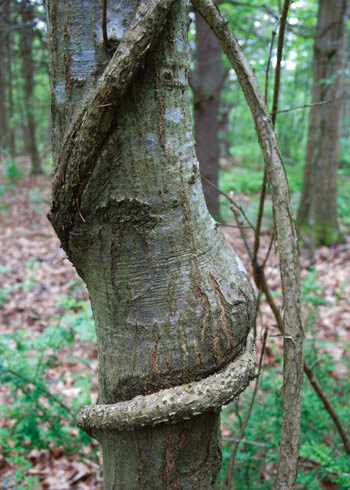
Estimating just how much time it will take to control a particular infestation isn’t easy. In 40 hours I have worked over a half dozen acres, and there are at least that many more to go. Early on, the clearing was conducted more intensively with lots of root pulling, while later efforts leaned more toward simple cutting. The forest edge, with its abundant sunlight is generally more inundated with vine growth, as well as other plants that impede progress. The work in the forest interior is somewhat less inhibited.
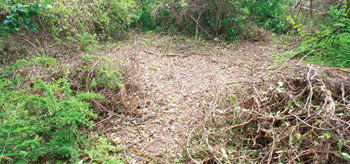
The leaves on the cut stems wilt and then flutter to the ground, creating an October mood in the mid-June forest. The larger pines and oaks will now thrive for decades without their cloak of vines. However, the smaller- to medium-sized specimens remain vulnerable to reinfestation without follow up efforts. Many of these stems are so disfigured that they’ve certainly lost any economic value as timber. Yet, the bittersweet growth clock has been set back to day one, and with persistent effort will remain a nuisance rather than a disaster.
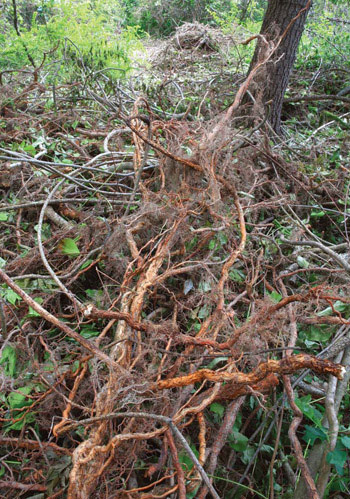
Practice Safe Wreathmaking
Oriental bittersweet was first imported to the United States in the 1860s as a landscape plant. Little did people know back then that the plant would become a maligned forest villain.
Today we know better, sort of. While it’s illegal for garden centers in many Northeastern states to sell oriental bittersweet plants, the plant’s branches and seeds are still sold, and spread, by people who make and distribute holiday wreaths made from naturalized oriental bittersweet.
If you’re going to buy a roadstand bittersweet wreath, or drive to the next town over and plunder vines from a farmer’s hedgerow to make your own, be aware that you’re engaging in at-risk botanical behavior. If you burn the wreath when you’re done with it, you may be all right, but abstinence is the only sure way of preventing unwanted bittersweet infestations around your compost pile. NW
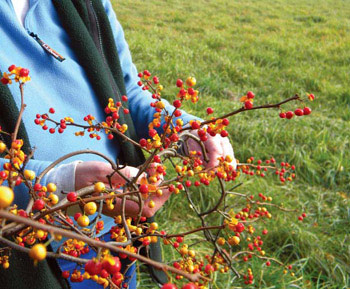


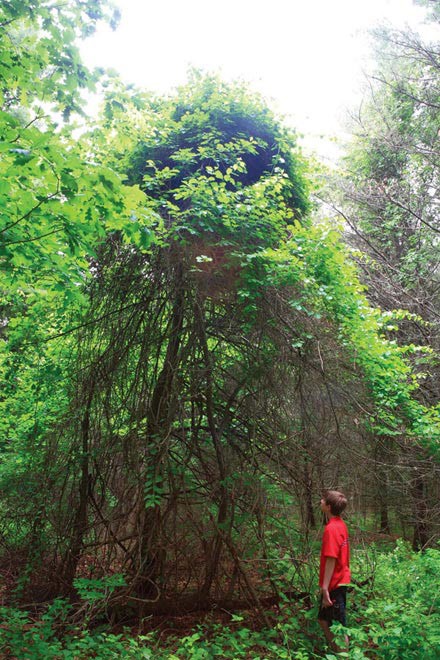
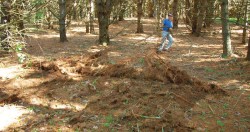
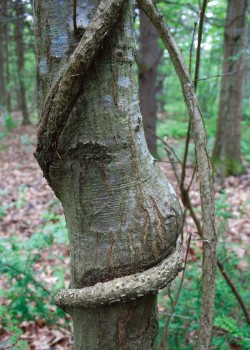
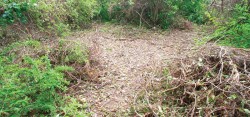
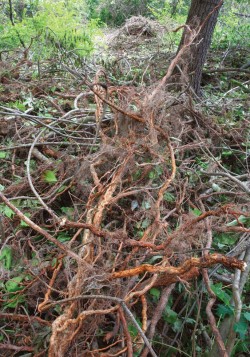
Discussion *